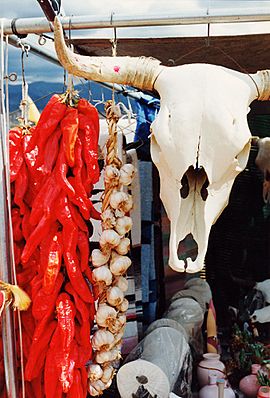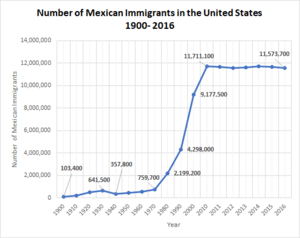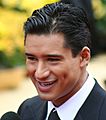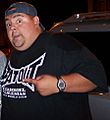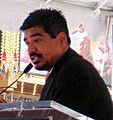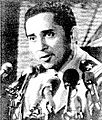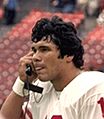Mexican American facts for kids
|
|||||||||||||||||||||||||||
| Total population | |||||||||||||||||||||||||||
|---|---|---|---|---|---|---|---|---|---|---|---|---|---|---|---|---|---|---|---|---|---|---|---|---|---|---|---|
| Mexican Americans 34,586,088 (2013) 10.94% of the US population.  |
|||||||||||||||||||||||||||
| Regions with significant populations | |||||||||||||||||||||||||||
| Southwest, West Coast, Upper Midwest. There are also emerging populations in the South and Northeast. | |||||||||||||||||||||||||||
| Languages | |||||||||||||||||||||||||||
| Spanish, American English, Spanglish, and a minority of Indigenous Mexican languages. | |||||||||||||||||||||||||||
| Religion | |||||||||||||||||||||||||||
| Predominantly Roman Catholic; minorities of Protestants, Indigenous beliefs, Unaffiliated | |||||||||||||||||||||||||||
| Related ethnic groups | |||||||||||||||||||||||||||
| Indigenous peoples of Mexico, Spaniards, Arabs, Mestizo, Hispanics | |||||||||||||||||||||||||||
Mexican Americans are Americans of Mexican ancestry. They account for 9% of the country's population: about 28.3 million Americans listed their ancestry as Mexican as of 2006. They form the largest Hispanic or Latino group in the United States and contain the largest group of White Hispanics. Mexican Americans trace their ancestry to the modern day country of Mexico or the Southwestern United States.
Most Mexican Americans live in the four states that border Mexico, California, Texas, Arizona and New Mexico. The areas in and around Los Angeles is home to over six million Mexican Americans. Many of these live in mainly Hispanic neighborhoods such as East Los Angeles. There are also a number of large Mexican American communities in other areas of the Western and Southwestern United States. Though Chicago is not in the Western or Southwestern United States, it has 1.4 million Mexican Americans, more Mexican Americans than any city except Los Angeles. The metro areas of Dallas, Houston, and Phoenix each have more than one million Mexicans. There are a growing number of Mexican Americans in the Midwest and South.
Most Mexican Americans are "mestizos", or of more than one ethnicity. Most of their heritage is the indigenous indios of Mexico, but it often contains other groups, such as Spanish, Italian, Irish and Native American tribes from the U.S. such as Apache.
Contents
History of Mexican Americans
In 1900, there were slightly more than 500,000 Hispanics of Mexican descent living in New Mexico, Arizona, Nevada, Colorado, California and Texas. Most were Mexican Americans of Spanish descent and other Hispanicized European settlers who settled in the Southwest during Spanish colonial times, as well as local and Mexican Indians.
As early as 1813, some of the Tejanos who colonized Texas in the Spanish Colonial Period established a government in Texas that desired independence from Spanish-ruled Mexico. In those days, there was no concept of identity as Mexican. Many Mexicans were more loyal to their states/provinces than to their country as a whole, which was a colony of Spain. This was particularly true in frontier regions such as Zacatecas, Texas, Yucatán, Oaxaca, New Mexico, etc.
As shown by the writings of colonial Tejanos such as Antonio Menchaca, the Texas Revolution was initially a colonial Tejano cause. Mexico encouraged immigration from the United States to settle east Texas and, by 1831, English-speaking settlers outnumbered Tejanos ten to one in the region. Both groups were settled mostly in the eastern part of the territory. The Mexican government became concerned about the increasing volume of Anglo-American immigration and restricted the number of settlers from the United States allowed to enter Texas. Consistent with its abolition of slavery, the Mexican government banned slavery within the state, which angered American slave owners. The American settlers, along with many of the Tejano, rebelled against the centralized authority of Mexico City and the Santa Anna regime, while other Tejano remained loyal to Mexico, and still others were neutral.
Author John P. Schmal wrote of the effect Texas independence had on the Tejano community:
A native of San Antonio, Juan Seguín is probably the most famous Tejano to be involved in the War of Texas Independence. His story is complex because he joined the Anglo rebels and helped defeat the Mexican forces of Santa Anna. But later on, as Mayor of San Antonio, he and other Tejanos felt the hostile encroachments of the growing Anglo power against them. After receiving a series of death threats, Seguín relocated his family in Mexico, where he was coerced into military service and fought against the US in 1846–1848 Mexican–American War.
Although the events of 1836 led to independence for the people of Texas, the Hispanic population of the state was very quickly disenfranchised, to the extent that their political representation in the Texas State Legislature disappeared entirely for several decades.
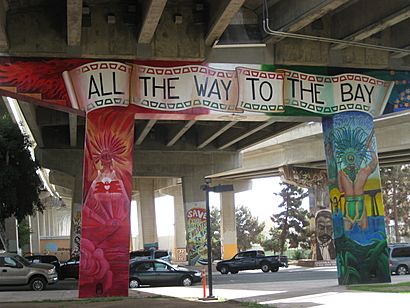
As a Spanish colony, the territory of California also had an established population of colonial settlers. Californios is the term for the Spanish-speaking residents of modern-day California; they were the original Mexicans (regardless of race) and local Hispanicized Indians in the region (Alta California) before the United States acquired it as a territory. In the mid-19th century, more settlers from the United States began to enter the territory.
In California, Spanish settlement began in 1769 with the establishment of the Presidio and Catholic mission of San Diego. 20 more missions were established along the California coast by 1823, along with military Presidios and civilian communities. Settlers in California tended to stay close to the coast and outside of the California interior. The California economy was based on agriculture and livestock. In contrast to central New Spain, coastal colonists found little mineral wealth. Some became farmers or ranchers, working for themselves on their own land or for other colonists. Government officials, priests, soldiers, and artisans settled in towns, missions, and presidios.
One of the most important events in the history of Mexican settlers in California occurred in 1833, when the Mexican Government secularized the missions. In effect this meant that the government took control of large and vast areas of land. These lands were eventually distributed among the population in the form of Ranchos, which soon became the basic socio-economic units of the province.
Relations between Californios and English-speaking settlers were relatively good until 1846, when military officer John C. Fremont arrived in Alta California with a United States force of 60 men on an exploratory expedition. Fremont made an agreement with Comandante Castro that he would stay in the San Joaquin Valley only for the winter, then move north to Oregon. However, Fremont remained in the Santa Clara Valley then headed towards Monterey. When Castro demanded that Fremont leave Alta California, Fremont rode to Gavilan Peak, raised a US flag and vowed to fight to the last man to defend it. After three days of tension, Fremont retreated to Oregon without a shot being fired.
With relations between Californios and Americans quickly souring, Fremont returned to Alta California, where he encouraged European-American settlers to seize a group of Castro's soldiers and their horses. Another group seized the Presidio of Sonoma and captured Mariano Vallejo.
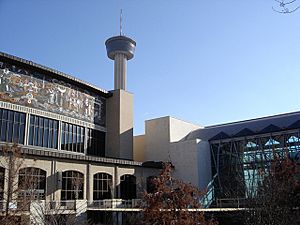
The Americans chose William B. Ide as chosen Commander in Chief and on July 5, he proclaimed the creation of the Bear Flag Republic. On July 9, US military forces reached Sonoma; they lowered the Bear Flag Republic's flag, replacing it with a US flag. Californios organized an army to defend themselves from invading American forces after the Mexican army retreated from Alta California to defend other parts of Mexico.
The Californios defeated an American force in Los Angeles on September 30, 1846. In turn, they were defeated after the Americans reinforced their forces in what is now southern California. Tens of thousands of miners and associated people arrived during the California Gold Rush, and their activities in some areas meant the end of the Californios' ranching lifestyle. Many of the English-speaking 49ers turned from mining to farming and moved, often illegally, onto land granted to Californios by the former Mexican government.
The United States had first come into conflict with Mexico in the 1830s, as the westward spread of United States settlements and of slavery brought significant numbers of new settlers into the region known as Tejas (modern-day Texas), then part of Mexico. The Mexican–American War, followed by the Treaty of Guadalupe Hidalgo in 1848 and the Gadsden Purchase in 1853, extended US control over a wide range of territory once held by Mexico, including the present-day borders of Texas and the states of New Mexico, Colorado, Utah, Nevada, Arizona, and California.
Although the treaty promised that the landowners in this newly acquired territory would have their property rights preserved and protected as if they were citizens of the United States, many former citizens of Mexico lost their land in lawsuits before state and federal courts over terms of land grants, or as a result of legislation passed after the treaty. Even those statutes which Congress passed to protect the owners of property at the time of the extension of the United States' borders, such as the 1851 California Land Act, had the effect of dispossessing Californio owners. They were ruined by the cost over years of having to maintain litigation to support their land titles.
Following the concession of California to the United States under the Treaty of Guadalupe Hidalgo, Mexicans were repeatedly targeted by legislation that targeted their socio-economic standing in the area. One significant instance of this is exemplified by the passage of legislation that placed the heaviest tax burden on land. The fact that there was such a heavy tax on land was important to the socio-economic standing of Mexican Americans, because it essentially limited their ability to keep possession of the Ranchos that had been originally granted to them by the Mexican government.
19th-century and 20th-century Mexican migration

In the late nineteenth century, liberal Mexican President Porfirio Díaz embarked on a program of economic modernization that triggered not only a wave of internal migration in Mexico from rural areas to cities, but also Mexican emigration to the United States. A railway network was constructed that connected central Mexico to the U.S. border and also opened up previously isolated regions. The second factor was the shift in land tenure that left Mexican peasants without title or access to land for farming on their own account. For the first time, Mexicans in increasing numbers migrated north into the U.S. for better economic opportunities. In the early 20th century, the first main period of migration to the United States happened between the 1910s to the 1920s, referred to as the Great Migration. During this time period the Mexican Revolution was taking place, creating turmoil within and against the Mexican government causing civilians to seek out economic and political stability in the United States. Over 1.3 million Mexicans relocated to the United States from 1910 well into the 1930s, with significant increases each decade. Many of these immigrants found agricultural work, being contracted under private laborers. The second period of increased migration is known as the Bracero Era from 1942 to 1964, referring to the Bracero program implemented by the United States, contracting agricultural labor from Mexico due to labor shortages from the World War II draft. An estimated 4.6 million Mexican immigrants were pulled into U.S. through the Bracero Program from the 1940s to the 1960s. The lack of agricultural laborers due to increases in military drafts for World War II opened up a chronic need for low wage workers to fill jobs.
20th century
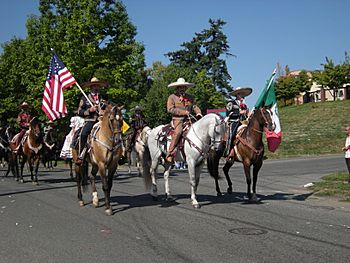
While Mexican Americans were once concentrated in the Southwest: California, Arizona, New Mexico, and Texas; during World War I they moved to industrial communities such as St. Louis, Chicago, Detroit, Cleveland, Pittsburgh, and other steel-producing regions, where they gained industrial jobs. Like European immigrants, they were attracted to work that did not require proficiency in English. Industrial restructuring in the second half of the century put many Mexican Americans out of work in addition to people of other ethnic groups. Their industrial skills were not as useful in the changing economies of these areas.
During the first half of the 20th century, Mexican-American workers formed unions of their own and joined integrated unions. The most significant union struggle involving Mexican Americans was the effort to organize agricultural workers and the United Farm Workers' long strike and boycott aimed at grape growers in the San Joaquin and Coachella valleys in the late 1960s. Leaders César Chávez and Dolores Huerta gained national prominence as they led a workers' rights organization that helped workers get unemployment insurance to an effective union of farmworkers almost overnight. The struggle to protect rights and sustainable wages for migrant workers has continued.
Since the late 20th century, undocumented Mexican immigrants have increasingly become a large part of the workforce in industries such as meat packing, where processing centers have moved closer to ranches in relatively isolated rural areas of the Midwest; in agriculture in the southeastern United States; and in the construction, landscaping, restaurant, hotel and other service industries throughout the country.

Mexican-American identity has changed throughout these years. Over the past hundred years, activist Mexican Americans have campaigned for their constitutional rights as citizens, to overturn discrimination in voting and to gain other civil rights. They have opposed educational and employment discrimination, and worked for economic and social advancement. In numerous locations, court cases have been filed under the Voting Rights Act of 1965 to challenge practices, such as poll taxes and literacy tests in English, that made it more difficult for Spanish-language minorities to register and vote. At the same time, many Mexican Americans have struggled with defining and maintaining their community's cultural identity as distinct from mainstream United States. That changes in response to the absorption of countless new immigrants.
In the 1960s and 1970s, some Latino/Hispanic student groups flirted with Mexican nationalism, and differences over the proper name for members of the community. Discussion over self-identification as Chicano/Chicana, Latino/Latina, Mexican Americans, or Hispanics became tied up with deeper disagreements over whether to integrate into or remain separate from mainstream American society. There were divisions between those Mexican Americans whose families had lived in the United States for two or more generations and more recent immigrants, in addition to distinctions from other Hispanic or Latino immigrants from nations in Central and South America with their own distinct cultural traditions.
During this period, civil rights groups such as the National Mexican-American Anti-Defamation Committee were founded. By the early 21st century, the states with the largest percentages and populations of Mexican Americans are California, Arizona, New Mexico, Texas, Colorado, Nevada, and Utah. There have also been markedly increasing populations in Oklahoma, Pennsylvania and Illinois.
In terms of religion, Mexican Americans are primarily Roman Catholic. A large minority are Evangelical Protestants. Notably, according to a Pew Hispanic Center report in 2006 and the Pew Religious Landscape Survey in 2008, Mexican Americans are significantly less likely than other Hispanic groups to abandon Catholicism for Protestant churches.
Notable people
Historical Figures
-
Juan Seguin, was a political and military figure of the Texas Revolution helping to establish the independence of Texas.
-
Romualdo Pacheco, became the 12th governor of California. He remains the first and only Latino Governor of California.
-
Octaviano Larrazolo, served as the fourth Governor of New Mexico and became the first Hispanic United States Senator.
-
Romana Acosta Bañuelos, became the first Hispanic Treasurer of the United States (1971–1974).
-
Cesar Chavez, a labor leader and civil rights activist, who, with Dolores Huerta, co-founded the United Farm Workers union, UFW).
-
Laura Harring became the first Hispanic woman crowned Miss USA.
Cinema
-
Myrtle Gonzalez, actress famous for her silent films in the 1910s, is considered the first female Latin star in Hollywood.
-
Ramon Novarro, actor promoted by MGM as a "Latin lover" who became a leading man and one of the top box office attractions of the 1920s and early 1930s.
-
Lupe Vélez, a stage and film actress nicknamed The Mexican Spitfire by the media whose career spanned from the 1920s to the 1940s. She has a star on the Hollywood Walk of Fame.
-
Gilbert Roland, film and television actor whose career spanned seven decades from the 1920s until the 1980s. He was twice nominated for the Golden Glove Award in 1952 and 1964, and inducted to the Hollywood Walk of Fame in 1960.
-
Anthony Quinn, actor, painter and writer. He starred in numerous critically acclaimed and commercially successful films. He won the Academy Award for Best Supporting Actor twice: for Viva Zapata! in 1952 and Lust for Life in 1956.
-
Lynda Carter, actress, singer, songwriter and beauty pageant titleholder who was crowned Miss World America 1972 and also the star of the television series Wonder Woman from 1975 to 1979.
-
Constance Marie nominated for Soap Opera Digest Awards
-
Danny Trejo, actor who has appeared in numerous Hollywood films, often as villains and anti-heroes.
-
Eva Longoria, actress, producer, director, and businesswoman. She received a Golden Globe Award and won two Screen Actors Guild Awards.
-
Michael Peña, actor and musician
-
Jessica Alba, Choice Actress Teen Choice Award and Saturn Award for Best Actress on Television, and a Golden Globe nomination.
-
Alexis Bledel an American actress and model. She is best known for her role as Rory Gilmore on the television series Gilmore Girls (2000–2007, 2016).
Music
-
Joan Baez, folk singer, songwriter, musician, and activist whose contemporary folk music often includes songs of protest or social justice.
-
Dave Navarro, rock star of several important bands in United States.
-
Carlos Santana, named by Rolling Stone magazine as one of the greatest guitarists of all time. He has won 10 Grammy Awards and three Latin Grammy Awards.
-
Vikki Carr singer and humanitarian who has performed in a variety of music genres, including jazz, pop and country, but has enjoyed her greatest success singing in Spanish. She had 10 singles that made the US pop charts and 13 albums that made the US pop-album charts.
-
Trini Lopez, singer, guitarist, and actor who scored 13 chart singles through 1968. On the adult contemporary chart, he racked up 15 hits. He became one of the country's top nightclub performers of that era, regularly headlining in Las Vegas.
-
Linda Ronstadt, popular music singer. She has earned 11 Grammy Awards, three American Music Awards, two Academy of Country Music awards, an Emmy Award, an ALMA Award, was a 2013 recipient of the National Medal of Arts and was inducted into the Rock and Roll Hall of Fame in April 2014.
-
Ritchie Valens was an American singer, songwriter and guitarist and a rock and roll pioneer.
-
Fergie Duhamel singer, songwriter and actress.
-
Demi Lovato, songwriter, actress and model who made her debut as a child actress in Barney & Friends. In 2008, Lovato rose to prominence in the Disney Channel television film Camp Rock and signed a recording contract with Hollywood Records.
-
Selena Gomez, actress and singer known for first featured on the children's series Barney & Friends in the early 2000s. She formed her band Selena Gomez & the Scene after signing a recording contract with Hollywood Records in 2008.
-
Becky G singer, songwriter, rapper, actress and model her musical style is an integration of pop-rap
-
Zack de la Rocha American musician, poet, rapper, and activist best known as the vocalist and lyricist of rap metal band Rage Against the Machine from 1991–2000.
-
Hope Sandoval lead singer for Mazzy Star and Hope Sandoval & the Warm Inventions. Grew up in a Mexican American family in East Los Angeles, California.
Journalists and Writers
Entertainment personalities
-
Jonas Rivera is an American film producer of famous Pixar animation films Up and Inside Out.
Comedians
Government
-
Raul H. Castro, was a United States Ambassador and the 14th Governor of Arizona (1975–77). He was the first Mexican-born American to be elected governor of Arizona.
-
Toney Anaya, U.S. Democratic politician who served as the 26th Governor of New Mexico from 1983 to 1987.
-
Bill Richardson, politician who was 30th Governor of New Mexico, from 2003 to 2011. He was U.S. Ambassador to the United Nations and Energy Secretary in the Clinton administration.
-
Alberto Gonzales, was the 80th United States Attorney General, appointed by President George W. Bush, becoming the highest-ranking Hispanic-American in Executive Branch government to date.
-
Ken Salazar, served as the 50th United States Secretary of the Interior from 2009 to 2013, and previously served as a United States Senator from Colorado from 2005 to 2009. He and Mel Martinez (R-Florida) were the first Hispanic U.S. Senators since 1977.
-
Brian Sandoval, is the 29th and current Governor of the U.S. state of Nevada and a member of the Republican Party. Sandoval is a former judge of the United States District Court for the District of Nevada.
-
Catherine Cortez Masto, U.S. Democratic politician and first female Hispanic U.S. senator.
-
Susana Martinez, is the 31st and current Governor of New Mexico and current chairman of the Republican Governors Association. She is the first Hispanic woman to be elected governor.
Rosa Rios (born July 17, 1965) is the 43rd and current Treasurer of the United States. A graduate of Harvard University, she was recently selected by the university as the first Latina in its 380-year history to have a portrait commissioned in her honor. She is the first Treasurer to have her current portfolio including oversight of the Bureau of Engraving and Printing, the United States Mint, Fort Knox, and Chair of the Advanced Counterfeiting Deterrence Steering Committee.
Business
-
Arte Moreno is the billionaire owner of the Anaheim Angels
-
Rosario Marin the 41st Treasurer of the United States
Military
-
Marcelino Serna an undocumented Mexican immigrant who became the most decorated soldier from Texas in World War I. Serna was the first Hispanic to be awarded the Distinguished Service Cross.
-
Guy Gabaldon a United States Marine who, at age 18, captured or persuaded to surrender Japanese soldiers and civilians during the battles for Saipan and Tinian islands in 1944 during World War II.
-
Marcario Garcia was the first Mexican immigrant to receive the Medal of Honor, the United States' highest military decoration. He received the award for his heroic actions as a soldier during World War II.
-
Major Oscar F. Perdomo a recipient of the Distinguished Service Cross, was a United States Air Force officer who was the last "ace in a day" for the United States in World War II.
-
Everett Alvarez, Jr. is a former U.S. Navy Commander who endured one of the longest periods as a prisoner of war (POW) in American military history. Alvarez was the first U.S. pilot to be downed and detained during the Vietnam War and spent over eight years in captivity.
-
Robert Cardenas is a retired brigadier general of the United States Air Force. He served in World War II and the Vietnam War
-
Richard E. Cavazos became the U.S. Army's first Hispanic Four Star General
-
Alfred Valenzuela is a retired United States Army major general who commanded United States Army South (USARSO) at Fort Buchanan, Puerto Rico.
Science and Technology
-
Jacob Bekenstein was a theoretical physicist who made fundamental contributions to the foundation of black hole thermodynamics and to other aspects of the connections between information and gravitation.
-
France Cordova is an astrophysicist, researcher and university administrator. As of March 2014, she is the director of the National Science Foundation. Previously, she was the eleventh President of Purdue University.
-
Alfredo Quinones-Hinojosa is a physician, author, and researcher. He is Director of the Brain Tumor Surgery Program at Johns Hopkins Bayview Medical Center, and the Director of the Brain Tumor Stem Cell Laboratory at Johns Hopkins School of Medicine.
-
Nora Volkow is the current director of the National Institute on Drug Abuse (NIDA), which is part of the National Institutes of Health (NIH).
-
Ellen Ochoa became the first Hispanic woman in the world to go into space. She is the current director of the Johnson Space Center.
-
Sidney M. Gutierrez former NASA Astronaut.
Sport
-
Pancho Gonzales has been rated one of the top players in the history of the sport.
-
Solly Smith, was the first world boxing champion of Hispanic descent.
-
Ted Williams, baseball hall of famer, seventeen time All-Star and regarded as one of the greatest hitters in baseball history.
-
Jim Plunkett, Heisman Trophy winner and two time Super Bowl winning quarterback.
-
Joe Kapp, is a member of the Canadian Football Hall of Fame, the B.C. Sports Hall of Fame, the BC Lions Wall of Fame, the College Football Hall of Fame. He is the only player to quarterback in the Super Bowl, Rose Bowl, and the Grey Cup.
-
Anthony Muñoz, a Pro Football Hall of Fame offensive tackle who played 13 seasons in the NFL earning eleven Pro Bowls. Muñoz is considered "one of the greatest offensive linemen in the history of the National Football League."
-
Brenda Villa, U.S. Olympian and the most decorated athlete in the world of women’s water polo.
-
Lee Trevino, professional golfer regarded as one of the greatest players in professional golf history, and the greatest Hispanic golfer of all time. He was inducted to the World Golf Hall of Fame in 1981.
-
Dallas Cowboys quarterback Tony Romo is the third ranked NFL career passing leader
-
Nomar Garciaparra, is a retired and six-time All-Star and current SportsNet LA analyst.
Related pages
Images for kids
-
Janet Murguía is president of UnidosUS, the United States' largest Latino nonprofit advocacy organization.
-
A Quinceañera celebration in Santa Fe, New Mexico
-
Sign from a restaurant in Dallas, Texas, now located in the National Civil Rights Museum
-
Mexican food has become part of the mainstream American market, just as Italian food did decades before and assimilated to the American market like Tex-Mex.
-
Jessica Alba's mother has Danish, Welsh, German and French ancestry, while her paternal grandparents, who were born in California, were the children of Mexican immigrants.
-
Map of Los Angeles County showing percentage of population self-identified as Mexican in ancestry or national origin by census tracts. Heaviest concentrations are in East Los Angeles, Echo Park/Silver Lake, South Los Angeles and San Pedro/Wilmington.
-
Mendez v. Westminster was a 1947 federal court case that challenged Mexican remedial schools in Orange County, California. In its ruling, the United States Court of Appeals for the Ninth Circuit, in an en banc decision, held that the forced segregation of Mexican American students into separate "Mexican schools" was unconstitutional and unlawful because Mexicans were white. It was the first ruling in the United States in favor of desegregation.
-
El Paso Morning Times newspaper January 30, 1917, headlinedː "Bill Before Legislature to Prevent Mexicans Voting" depicts the 1917 Bath Riots begun by Carmelita Torres at the Santa Fe International Bridge disinfecting plant at the El Paso, Texas and Juarez, Mexico border.
-
Sal Castro was a Mexican-American educator and activist. He was most well known for his role in the 1968 East L.A. walkouts. See Walkout (film).
-
Lauro Cavazos, Secretary of Education from August 1988 to December 1990
-
Oasis Drive Inn with mural of a scarlet macaw on US Highway 83 in Crystal City, Texas
-
City Terrace streets
-
Two Mexican American boys at a Día de Los Muertos celebration in Greeley, Colorado
-
Los Angeles attracts Mexican American immigrants because of its rich Spanish and Mexican architecture, history and culture.
-
Original Ninfa's on Navigation Boulevard, established by Ninfa Laurenzo
See also
 In Spanish: Inmigración mexicana en los Estados Unidos para niños
In Spanish: Inmigración mexicana en los Estados Unidos para niños




























